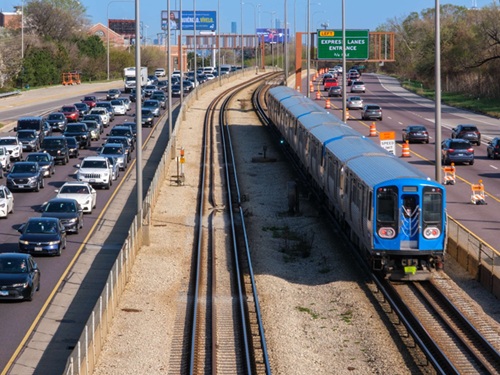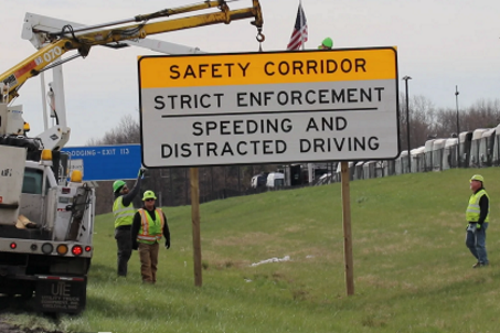Distracted driving is an increasing problem on U.S. roadways, with crashes involving a distracted driver killing 3,142 people in 2019 – the latest year for which data is available – which is up nearly 10 percent from 2018.
[Above photo by the Ohio DOT]
Every state currently has restrictions in place to address distracted driving, but the laws vary in scope and rigor. Some states – including Ohio, Michigan and Utah – are considering legislation in 2021 to enhance their distracted driving laws.
State departments of transportation are also engaged in a variety of efforts to reduce distracted driving.

In July 2020, the Ohio Department of Transportation and Ohio State Highway Patrol created a 12-mile long distracted driving safety corridor running along U.S. 33 between the Fairfield/Franklin County Line and SR 188.
Since its implementation, OSHP troopers significantly increased enforcement on U.S. 33, which resulted in fewer crashes and fatalities. From July 2020 through April 2021, the Ohio DOT noted in a statement that distracted driving crashes along that corridor declined by 44 percent while fatalities dropped 61 percent as compared the timeframe between 2019 and 2020.
Distracted driving is still near the top of the list when it comes to crashes on Texas roadways, coming in second place for traffic-related crash causes, according to the Texas Department of Transportation.
The agency added that, in 2020, distracted drivers caused nearly one in five crashes in Texas – crashes that killed 364 people and seriously injured another 2,200.

“A serious or fatal crash can happen in an instant,” said James Bass, TxDOT’s outgoing executive director, in a statement. “If you’re distracted by your phone, or doing anything else that takes your focus away from driving, you’re putting yourself, your passengers and everyone else on the road at risk. Distracted driving crashes are 100 percent preventable.”
As a result, TxDOT is re-launching its web-based augmented reality game “Dart Those Distractions” to reinforce the importance of paying attention behind the wheel.
The Transportation Research Board recently noted in a blog post that when a person reads a text while driving, their eyes are off the road for an average of five seconds. At 55 miles per hour, that is equivalent driving the length of a football field while blindfolded, the group said.

TRB’s Behavioral Traffic Safety Cooperative Research Program or BTSCRP offers an array of resources, best practices, and tools such model legislation and presentations for law enforcement in a recent report: Using Electronic Devices While Driving: Legislation and Enforcement Implications.
Jurisdictions with strong traffic safety laws, supported by enforcement, public education, and outreach, tend to have lower overall traffic fatality rates, noted Amy Benedick; a researcher with Westat who helped compiled the BTSCRP report.
The most effective laws and safety policy to curb the use of distracting devices while driving had the following common elements, according to that report:
- Unambiguous language that clearly defines when and how a wireless device can and cannot be used.
- Penalties and fines in line with other traffic citations.
- A combination of high-visibility enforcement of the law and targeted public information, education and outreach campaigns.
- Sustained coalition-building efforts.
Benedick also spoke with TRB’s Transportation Explorer’s podcast about some of the most effective strategies for combated distracted driving.
“There has to be strong legislation,” she explained. “There has to be a willingness to educate the public on why driving while distracted is an important safety concern, and there has to be an understanding that electronic device use enforcement is an important part of a traffic safety program.”
To that end, the AAA, Advocates for Highway and Auto Safety, the Governors Highway Safety Association, the Insurance Institute for Highway Safety, and the National Safety Council recently unveiled a collaborative “checklist” that can serve as a roadmap for communities that are establishing or expanding automated enforcement programs.
“Research by IIHS and others has shown consistently that automated enforcement curbs dangerous driving behaviors and reduces crashes,” noted IIHS President David Harkey in a statement. “We hope this document developed with our highway safety partners will help communities take full advantage of this tool.”
 Nation
Nation


